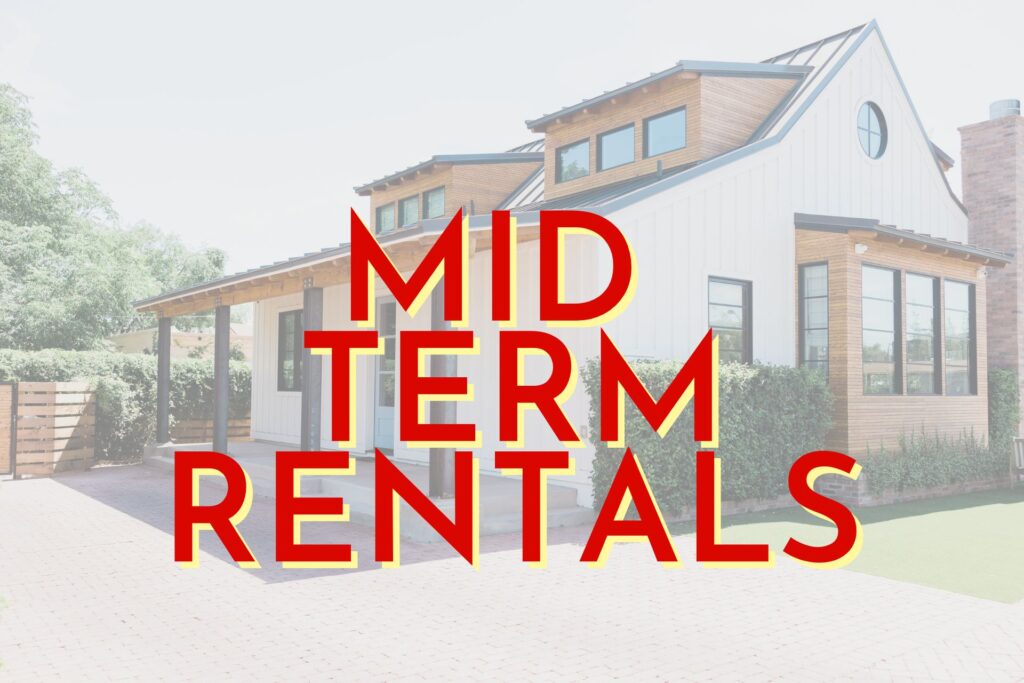A Practical Guide to Mid Term Rentals (First Hand Experience)
Mid term rentals (or medium term MTR) have seen an increase in popularity in recent years. In this article you’ll discover reasons why this could be a viable renting strategy for you. I combine mid term and short term leases at one of my properties and I’ve been a co-host for a few years. I’ll explain to you what are pros of MTR (and also a few obstacles). When does have the sense to rent on a mid term lease? Stay with me to find out.
What are mid term rentals?
Mid-term rentals, also known as medium-term rentals (MTR), refer to rental agreements that fall between short-term and long-term leases. While short-term rentals typically last a few days to a few weeks, and long-term rentals typically last at least one year, mid-term rentals span anywhere from one month to one year.
This flexible duration makes them an attractive option for both landlords and tenants looking for a more extended yet temporary housing solution. The proof of the rising demand for short term rentals is that even giant Airbnb introduced this housing option in times when the Covid-19 pandemic hit.
Why start with mid term rentals?
Short-term renting is my first choice, but sometimes it is more viable and less of a hassle to go with MTR. There is no doubt that STR brings in higher income, but there are also other factors to take into consideration.
If you’re a property owner or investor, there are several compelling reasons to consider mid-term rentals as part of your renting strategy.
Firstly, mid-term rentals can provide a more consistent income stream compared to short-term rentals, as you have longer-term tenants occupying your property.

Less guest turnover means spending less effort on constant marketing, organizing cleaning, communicating with many guests.
Additionally, mid-term rentals often attract tenants who are in need of temporary housing due to various reasons, such as job relocations, home renovations, or extended business trips. There are also digital nomads traveling around while working on their laptops. By targeting these market segments, you can tap into a steady demand for short-term housing.
Another option MTR brings to the table is the possibility to combine them with short term rentals. That’s great for places where seasonality has an influence on tourist turnover. During peak season you rent short term (to maximize revenue) and during low season offer mid term.
Finally, the regulation of short-term rentals in the US largely depends on the city. Each city has a specific set of rules regarding non-owner occupied real estate. In cases of heavy restrictions on STR or if prices are insanely high, a better option is to go with medium term.
Pros and cons
Let’s look at the major pros and cons of running MTR hosts must know about.
Pros:
Less turnover – Guests stay at least a month which means less frequent cleaning and you spend less time managing the property.
Strict cancellation policy – On Airbnb (and similar goes for other booking OTAs ) mid term rentals fall under a strict cancellation policy, which means it’s hard for guests to cancel the reservation without financial consequences.
Signing a lease – MTRs are subject to standard landlord-tenant laws – you sign a lease agreement that protects you as the owner and defines tenant rights.
No business tax – Only income tax is required (business tax is not needed).
Clients from ALE companies – Besides major booking platforms like Airbnb, Vrbo, Furnishfinder you can collaborate with ALE insurance service companies. (read on to find out more)
Less-problematic guests – It’s much less likely that guests on a business trip or families would throw a party in your rental.
Earn more than LTR – No doubt that you earn more compared to renting a property on a long term lease.
Cons:
Fewer earnings than STR – The reason why the majority of us prefer STR is income. Earnings with STR are around 35% higher on average.
More marketing efforts (arguably) – STRs have enormous guest turnover. The demand for mid-term rentals is rising, but it may still require additional effort for strategic planning and marketing your rental.
Wear and tear – You can never exclude untidy guests, and the fact that they live there every day means the wear and tear levels will naturally increase. I recommend introducing cleaning at agreed intervals during their stay.
The danger of squatters – This is the worst horror that can happen, so it’s better to be warned than to worry about the consequences.
Consulting with lawyers – From the legal standpoint for mid-term rentals, it’s necessary to sign a lease agreement. Due to the above-mentioned squatters and regulations that vary depending on the city, it’s best to find a good lawyer to create a contract that will protect you.
Who books medium term rentals?
Mid-term rentals cater to a diverse range of tenants. In the following text look at some common scenarios in which individuals or groups might seek out mid-term housing:
Extended business trips: People traveling for extended business trips may prefer the comfort and convenience of a home-like environment rather than a hotel.
Home renovations: Homeowners undergoing significant renovations need alternative housing for the duration of the construction work. (You might find them through ALE insurance service companies, more about it later.)
Academics and students: Students attending short-term courses or academics will rather sign a mid term lease. It’s a more suitable and still cheaper alternative to long-term leases.
Temporary jobs: Individuals on temporary work assignments or contract jobs might seek mid-term rentals to avoid the hassle of signing long-term leases (traveling nurses for example).
People move to another city: As they take time to buy the right property.
Digital nomads: I would expect people working on their laptops to go abroad, seeking countries with a lower cost of living compared to the US. However, they also explore different states within the US.
Mid term rental lease agreement
According to the law, mid-term rentals fall under the category of long-term rentals. Even if your guest books through Airbnb or another platform, you still need a lease agreement. The biggest fear hosts have is of squatters. Since this is a long-term lease, tenants can bring up tenant rights issues.

According to tenant rights, you need to give them a 30-day notice if you want them to leave. It’s technically possible that they stay for free for 30 days if you didn’t provide the notice (tenant rights law). It’s a kind of gap in the system bad guests could use.
Never rely on a random agreement you find on the internet! Each city has different regulations, so you should comply with those. Find a good lawyer and additionally see what other apartment renters in your area do.
In general, a lease agreement should include key points such as:
Lease term – Clearly specify the duration of the lease, including the start and end dates. ( 30, 60, 90, or 120+ days, and stipulate that tenants must provide a 30-day notice if they intend to vacate. Once the initial 30 days have passed and the tenant continues on a month-to-month basis, it is important to receive notification whether they plan to extend their stay for another month or if they will be leaving)
Rent payment – State the amount of rent, due dates, and accepted payment methods.
Security deposit – Determine the amount of the security deposit and outline the conditions for its return at the end of the lease.
Maintenance and repairs: Clarify the responsibilities of the landlord and tenant regarding maintenance, repairs, and property upkeep. (I send cleaning service once in 15 days. I put it in the agreement because I want to prevent surprises when the lease ends)
Termination clauses: Include provisions for early termination, renewal options, and any penalties or fees associated with breaking the lease.
House rules: Establish guidelines regarding noise, pets, smoking, and any other specific rules that are important to you as the landlord.
How to market your MTR?
The fastest way is to put your listing out on the major booking portals: Airbnb, Vrbo, Furnishfinder. I have a listing on Airbnb and Vrbo and that works for me, also if I combine STR and MTR.
However, there are ALE (additional living expenses) insurance companies that provide temporary living space for temporary displaced families due to a claim, house reconstruction, natural catastrophes and other reasons.
Here are the websites of the ones I know about. In each of them, you can register your listing:
CRS- The Complete Relocation Search Portal
Conclusion
Mid-term rentals are a great middle option if managing vacation rentals with a constant guest turnover is just too much for you. Using this option, you can enjoy a steady stream of income.
In certain situations, mid-term renting is more profitable than short-term, especially during off-season periods, as I have experienced myself. Or if your city has banned STR.
It’s highly likely that this market will continue to grow in the future. So, if you haven’t already jumped on this train, it may be time for serious considerations.
